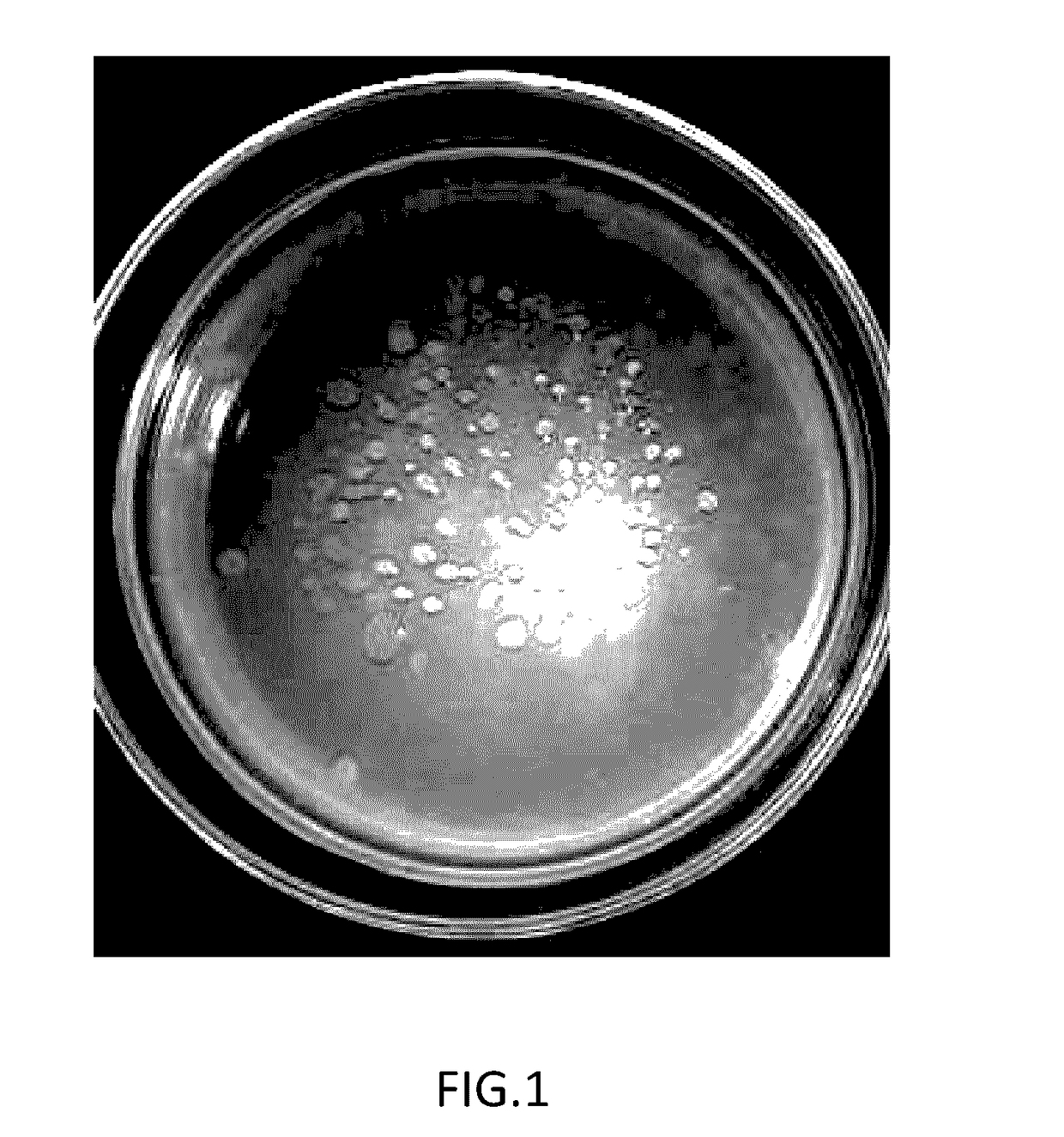Method of identifying whether Azotobacter secrets ammonia using nitrogen-free solid incubation media
a technology of ammonia and incubation media, which is applied in the field of identifying whether ammonia secretion is azotobacter using nitrogen-free solid incubation media, can solve the problems of weak plant promotion capacity and bacteria not fixing nitrogen in vitro
- Summary
- Abstract
- Description
- Claims
- Application Information
AI Technical Summary
Benefits of technology
Problems solved by technology
Method used
Image
Examples
example 1
[0020]A kind of nitrogen-free incubation media consisting of the following materials in each liter:
K2HPO40.5gMgSO4•7H2O0.1gCaCl2•2H2O0.05gGlucose7gFeSO4•7H2O0.005gNaMoO4•2H2O0.005gAgar10g
Distilled water to balance.
[0021]A method of identifying whether Azotobacter secrets ammonia using nitrogen-free solid incubation media, which comprising the steps of:
[0022](1) mixing above K2HPO4, MgSO4.7H2O, CaCl2.2H2O, glucose, FeSO4.7H2O, NaMoO4.2H2O, agar and distilled water together and stirring to obtain nitrogen-free incubation media;
[0023](2) the preparation of double-layer plates are by sterilizing said nitrogen-free incubation media in said step 1 at 118° C. for 15 minutes, then adding 1 mL indicator bacteria solution into every 100 mL nitrogen-free incubation media when the temperature dropped to 46° C. after sterilization, and then pouring nitrogen-free incubation media containing indicator bacteria immediately into sterile petri dish and mixing them, followed by controlling thickness o...
example 2
[0028]A kind of nitrogen-free incubation media consisting of the following materials in each liter:
K2HPO41gMgSO4•7H2O0.2gCaCl2•2H2O0.1gGlucose10gFeSO4•7H2O0.01gNaMoO4•2H2O0.008gAgar15g
Distilled water to balance.
[0029]A method of identifying whether Azotobacter secrets ammonia using nitrogen-free solid incubation media, which comprising the steps of:
[0030](1) mixing above K2HPO4, MgSO4.7H2O, CaCl2.2H2O, glucose, FeSO4.7H2O, NaMoO4.2H2O, agar and distilled water together and stirring to obtain nitrogen-free incubation media;
[0031](2) the preparation of double-layer plates are by sterilizing said nitrogen-free incubation media in said step 1 at 121° C. for 20 minutes, then adding 1 mL indicator bacteria solution into every 100 mL nitrogen-free incubation media when the temperature dropped to 47° C. after sterilization, and then pouring nitrogen-free incubation media containing indicator bacteria immediately into sterile petri dish and mixing them, followed by controlling thickness of n...
example 3
[0037]A kind of nitrogen-free incubation media consisting of the following materials in each liter:
K2HPO41.5gMgSO4•7H2O0.3gCaCl2•2H2O0.1gGlucose12gFeSO4•7H2O0.01gNaMoO4•2H2O0.0051gAgar16g
Distilled water to balance.
[0038]A method of identifying whether Azotobacter secrets ammonia using nitrogen-free solid incubation media, which comprising the steps of:
[0039](1) mixing above K2HPO4, MgSO4.7H2O, CaCl2.2H2O, glucose, FeSO4.7H2O, NaMoO4.2H2O, agar and distilled water together and stirring to obtain nitrogen-free incubation media;
[0040](2) the preparation of double-layer plates are by sterilizing said nitrogen-free incubation media in said step 1 at 118-124° C. for 25 minutes, then adding 1 mL indicator bacteria solution into every 100 mL nitrogen-free incubation media when the temperature dropped to 47° C. after sterilization, and then pouring nitrogen-free incubation media containing indicator bacteria immediately into sterile petri dish and mixing them, followed by controlling thickne...
PUM
 Login to View More
Login to View More Abstract
Description
Claims
Application Information
 Login to View More
Login to View More - R&D
- Intellectual Property
- Life Sciences
- Materials
- Tech Scout
- Unparalleled Data Quality
- Higher Quality Content
- 60% Fewer Hallucinations
Browse by: Latest US Patents, China's latest patents, Technical Efficacy Thesaurus, Application Domain, Technology Topic, Popular Technical Reports.
© 2025 PatSnap. All rights reserved.Legal|Privacy policy|Modern Slavery Act Transparency Statement|Sitemap|About US| Contact US: help@patsnap.com


